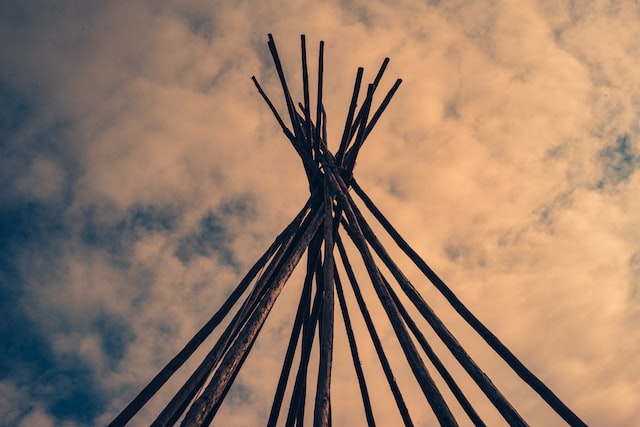The tipi and wigwam are two different types of shelters that have been used by Native Americans for centuries. The tipi is more portable due to its cone-shaped design while the wigwam is larger and sturdier but less flexible.
What is a tipi?
(Photo by MJ Tangonan on Unsplash )

A tipi (also known as a teepee) is a Native American dwelling that is traditionally made of animal skins and poles. The word “tipi” comes from the Lakota language, and it literally means “dwelling.” Tipis are designed to be portable so that they can easily be moved from one location to another. They are also very sturdy, which makes them ideal for harsh weather conditions.
What is a wigwam?
(Photo by RichardBH on Flickr)
 Wigwams, on the other hand, are Native American dwellings that are typically made out of bark or reeds. They are not as portable as tipis, but they can provide more protection from the elements. Wigwams were historically used by many different Native American tribes, including the Algonquin, Iroquois, and Cherokee.
Wigwams, on the other hand, are Native American dwellings that are typically made out of bark or reeds. They are not as portable as tipis, but they can provide more protection from the elements. Wigwams were historically used by many different Native American tribes, including the Algonquin, Iroquois, and Cherokee.
The difference between a tipi and a wigwam
A tipi is a conical shaped tent that is made with wooden poles and covered with animal skins or hides. The word “tipi” actually comes from the Lakota word “thipi”, which means “house” or “dwelling” . A wigwam, on the other hand, is a dome-shaped structure that is made with bent saplings and covered with birch bark or rush mats. The word “wigwam” comes from the Algonquian word “wikwom”, which means “dwelling place”.
How to choose the right shelter for your needs
When it comes to choosing the right shelter for your needs, there are a few things to consider. First, think about what kind of climate you’ll be using the shelter in. If you’re planning on spending time in cold weather, you’ll want a shelter that’s well-insulated and won’t let heat escape. On the other hand, if you’re only using the shelter in fair weather, insulation may not be as important.
Another thing to consider is how much space you need. If you’re planning on using the shelter for extended periods of time, or if you need to store a lot of gear, you’ll want something that’s spacious. However, if you only need a small shelter for short trips, something more compact might be better.
Finally, think about what kind of features you need in a shelter. Do you need a stove for cooking? Do you need a place to store your gear? Do you need windows for ventilation? Once you’ve considered all of these factors, you can start looking at specific shelters and comparing them to find the best one for your needs.
What advantage did a tipi have over a wigwam?
- A teepee is much easier to construct than a wigwam. All you need are some long poles and some animal skins or other materials to use as walls and a roof. A wigwam, on the other hand, requires more materials and is more complex to build.
- A teepee is more portable than a wigwam. If you need to move, you can simply take down your teepee and set it up again at your new location. A wigwam is not as easy to move because it is made of heavier materials and is not as collapsible.
- A teepee provides better ventilation than a wigwam. The opening at the top of the teepee allows hot air to escape, while the smaller openings at the bottom provide fresh air circulation. This makes it more comfortable to live in during hot weather.
- A teepee can be easily decorated with paintings or other decorations, inside and out. This personalization makes it feel like home. Wigwams are not as easy to decorate because of their shape and the material they are made of.
History of wigwam
A wigwam is a type of dwelling used by certain Native American tribes. It is usually made out of bent saplings covered with bark or hides and has an opening at the top for smoke to escape. The word “wigwam” comes from the Algonquian language, and means “house” or “dwelling”.
Wigwams were typically used as seasonal dwellings and were easy to construct and take down when the tribe needed to move. They could also be easily expanded if more space was needed. Some tribes would use wigwams as storage units during the winter when their food supplies were low and they needed to conserve what they had.
Wigwams were usually built close to water sources, as the Native Americans who lived in them relied heavily on fishing for their food. They would also build them near hunting grounds, so that they could more easily track and kill game. In some cases, wigwams were even built on top of burial mounds, so that the dead could be close to their families even after death.
Wigwams were usually made with an arched frame of saplings or bent tree limbs, covered with sheets of bark or animal skins. The doors were low and small, and usually had a flap that could be opened or closed to keep out the weather.
Wigwams were used as temporary homes by many nomadic tribes, as they could be easily dismantled and carried with them when they moved camp. Some tribes, like the Iroquois, did build more permanent structures, using wood posts and lashing them together with strips of hide. These more permanent wigwams were often used as winter homes, as they were better insulated than the mobile ones.
The size of a wigwam varied depending on the tribe that built it and its purpose. Some were small enough for just one person to sleep in, while others could fit an entire family. Today, there are still a few Native American tribes who live in wigwams. However, most have switched to more modern forms of housing, such as tipis or houses made out of lumber.
Frequently asked questions about tipis and wigwams
How did Native Americans keep rain out of teepee?
When Native Americans wanted to keep rain out of their teepees, they would put an extra layer of buffalo skin or hide over the top of the opening. They would also make sure that the opening was facing away from the wind and rain.
Why do teepees have 13 poles?
Some say that the teepee was modeled after the cone-shaped mountains found in the western region of North America. Others claim that the 13 poles represent the 13 phases of the moon or the 13 seasons experienced by Native Americans. No matter what the reasoning is behind it, the use of 13 poles to build a teepee is an integral part of many Native American cultures.
Does wigwam still exist?
Yes, wigwams still exist. They are often used as tourist attractions or for educational purposes, to show people how Native Americans once lived. While some wigwams are still used as homes by Native Americans, they are not as common as they once were.
Why do teepee doors face east?
There are a few reasons why teepee doors face east. One reason is that it symbolically represents the rising sun. Another reason is that it allows for the soft morning light to enter the teepee, which can be a nice way to start the day. Additionally, facing the door eastward also allows for any natural breezes to come in and cool down the teepee during hot summer days.
Why is there a hole in the top of teepees?
When Native Americans originally designed teepees, they did not intend for there to be a hole in the top. The hole was created as a result of the way the teepee was constructed. Teepees are made by stretching animal skins over a frame of wooden poles. The skin is then sewn together at the top, leaving a small opening. This opening can be used for ventilation or to allow smoke from a fire to escape.
Can teepees withstand wind?
Teepees are designed to withstand high winds and severe weather conditions. The conical shape of the teepee allows wind to pass through the structure, which prevents the teepee from being blown over. The frame of the teepee is also very sturdy, and the hides that cover the teepee provide additional protection from the wind.
How long does a wigwam last?
A wigwam is a semi-permanent structure that can last for many years if it is properly cared for. The frame of the wigwam is made from bent saplings or branches, and the walls are made from overlapping sheets of bark or hides. The wigwam has a conical shape and is usually covered with a thatched roof.
How long did teepees last?
The average lifespan of a teepee was about 15 to 20 years. But, some teepees lasted much longer—one was even said to have been in use for over 40 years. The secret to a long-lasting teepee is in the materials and construction.
How many people can sleep in a teepee?
A small teepee might only be able to accommodate two or three people, while a larger teepee could potentially sleep up to 10 people. Of course, the number of people that can actually comfortably sleep in a teepee will also depend on how much space each person has and how close they are to one another.
Featured Image by – Photo by Ehud Neuhaus on Unsplash








